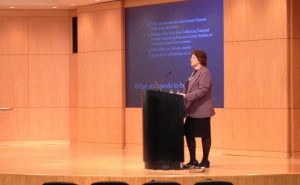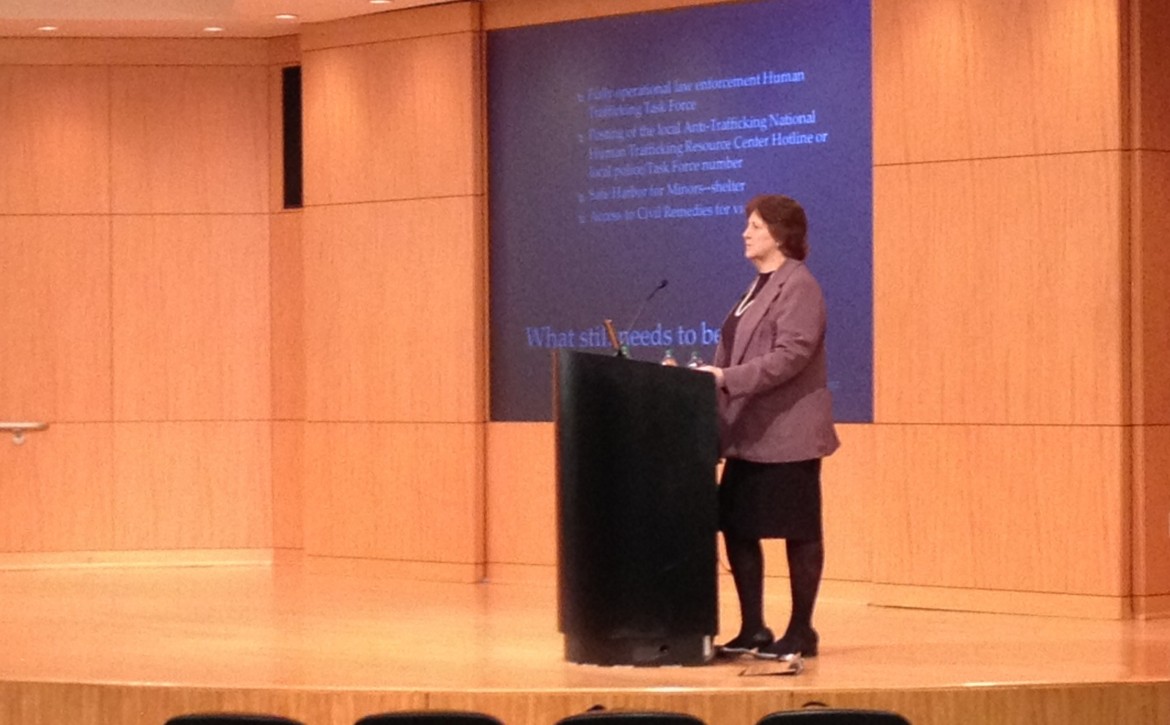
Maria Velikonja speaking at the "Not in Georgia: Combating Human Sex Trafficking" conference at Georgia State University.
Teachers can be the first line of defense against child sex trafficking, according to Maria Velikonja, a former FBI agent who has worked on human trafficking issues for the United Nations. During a two-day conference on sex trafficking at Georgia State University, in Atlanta, Velikonja spoke about the warning signs educators should watch for in their students and what teachers can do to keep their students safe.
The conference, Not in Georgia: Combating Human Sex Trafficking, organized by the Georgia Department of Education, was the third part of an ongoing series of lectures on the sex trade. In a lecture titled, “Combating Human Sex Trafficking in Georgia: What Public School Educators Can Do,” Velikonja began by outlining some of the basics of sex trafficking for teachers.
“What does a potential sex trafficking victim look like?” she asked the small crowd. “They could look like anyone. They could be short, tall, fat or skinny. It doesn’t matter.”
So, if victims of sex trafficking come in all shapes and sizes, what other indicators can teachers watch for?
Teachers should be on the lookout for certain socio-economic factors, Velikonja says. Children living in poverty and children from single-parent households are at risk.
But more important is whether their parents are paying attention and this is not limited to low-income families, she says. In fact, upper- and middle- class families with busy, distracted parents are equally at risk.
The Office of Justice Programs says as many as 300,000 children are at risk for sexual exploitation each year in the U.S. According to Velikonja, they could be boys or girls.But one of the key indicators teachers should watch for is poor or failing grades.
Another alarm for teachers are girls with much older boyfriends, Velikonja said.
“You might see a 13-year-old girl who suddenly starts dating a 17-year-old,” she said.
But, for teachers, it may not always be as simple as having a keen eye, as a great deal of prostitution has moved to the Internet. Text messaging, Facebook and online instant messaging have given child predators easier access to young people who are often not as wary of strangers online as they would be in real life, Velikonja said.
The U.S. Department of Education says teachers should be on the lookout for the following potential indications that a child is a victim of sex trafficking:
- Has unexplained absences from school for a period of time, and is therefore a truant
- Demonstrates an inability to attend school on a regular basis
- Chronically runs away from home
- Makes references to frequent travel to other cities
- Exhibits bruises or other physical trauma, withdrawn behavior, depression, or fear
- Lacks control over her or his schedule or identification documents
- Is hungry-malnourished or inappropriately dressed (based on weather conditions or surroundings)
- Shows signs of drug addiction
However, protecting students from the sex trade extends beyond simply acting as a watchdog, Velikonja says. In the classroom, teachers should emphasize that children involved in the sex trade are victims and that the sex trade is not glamorous.
Most important is to teach kids that, reporting incidents is important. If someone they know is involved in the sex trade, not telling adults will only hurt the victim.
In the end, it’s critical parents need to be educated.
“Kids may be easily scared by this,” Velikonja said. “But speaking directly to parents may be more effective.”
Parents need to make students aware of child predators, both online and in real life, she said.
Jessica Smith, a spokesperson for Wellspring Living, a group that helps victims of sexual abuse, said it's up to parents to monitor their children's use of social media, such as Facebook and Twitter.
"Most of these transactions happen online," she wrote in an email. "It's the new 'street.'"
Equally as important for parents is to know who your children are friends with.
"Know their friends and where they are going -- always," Smith said. "We have so many stories of girls getting into this because of a friend and being trafficked right under their parent's noses. Know the parents of their friends."
As Velikonja drew her presentation to a close, audience members shared what actions they were planning to take moving forward to combat sex trafficking. Many were going to take further classes about sex trafficking.
One audience member asked the crowd if sex trafficking was being taught in sex education classes in the schools.
One teacher responded, “We’re working on it. We’re working on making it a part of curriculum in social studies classes.
Wednesday, several hundred advocates gathered in front of the Georgia capitol to celebrate the one-year anniversary of the passage of a tough, new anti-trafficking law. Supporters wore purple scarves. The bill increased penalties for those engaging in child sex trafficking.
